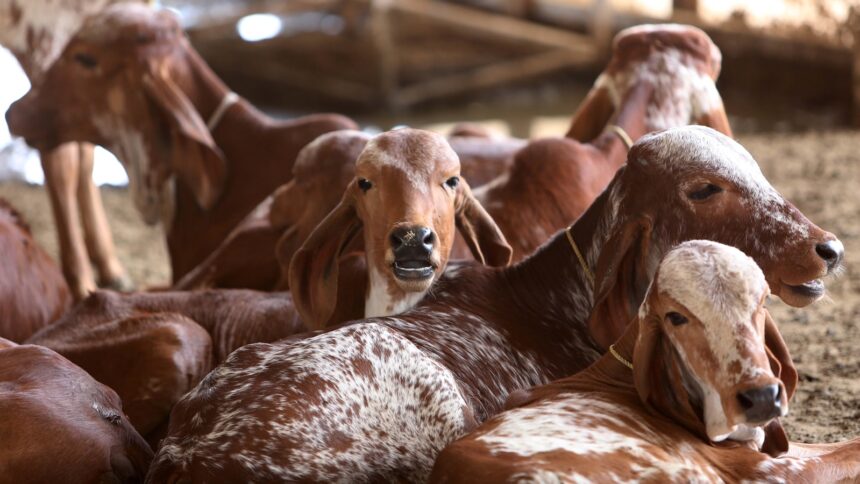How should India ensure the conservation of its indigenous cattle breeds — whether those reared for milk (Gir, Red Sindhi, Sahiwal and Tharparkar) or for both milch and draught purposes (Kankrej, Ongole, Rathi, Deoni, Hariana, Mewati and Dangi)?
“By allowing export of their frozen semen and embryos, which will make it more viable for farmers to maintain these animals and ‘Breed in India’,” says Madan , the president of the International Federation of Indigenous Zebu Cattle of India (IFIZCI).
Exports of both live bovine and their germplasm from India are under the “restricted list”, while allowed only against licence issued by the Directorate General of Foreign Trade on the recommendation of the Department of Animal Husbandry & Dairying. It’s the latter restriction, on export of cattle germplasm, that Yadav is wanting to be relaxed, if not removed.
Yadav and his brother Krishna Mohan have a 150-acre farm, Gir Amritphal Gaushala, spread over Harchandpur and Nimoth villages of Sohna tehsil in Haryana’s Gurugram district. It has 930 cows, calves and bulls in all — 750 Gir, 150 Nari (a dual-purpose breed native to Rajasthan and Gujarat) and 10 each of Red Sindhi, Hariana and Punganur (a dwarf hill breed believed to have descended from Ongole cattle).
The animals are housed in 40 acres of covered gaushala space. They are kept untied, machine-milked and fed largely on fodder grown in the remaining 110 acres. These include Super Napier (a perennial grass) and jowar (sorghum) during May-July, rajka (lucerne) during August-November and fodder from carrot, chukandar (beetroot), shalgam (turnip) and moringa during December-April.
“This is a loss-making activity,” admits Yadav, whose main business is a 3,500-vehicle fleet transportation company, Deneb & Pollux Tours and Travels, apart from a boutique hotel in Udaipur and restaurant in Gurugram. The 51-year-old is also a collector of vintage cars — he owns 374 of them, besides 109 heritage motorcycles and 55 antique tractors. “I have two ‘C’ or ‘G’ passions: Cows and Cars or Gai and Gaadi,” he declares.
Milk yields from indigenous cows are only 1,500-2,000 kg per year for Kankrej, Red Sindhi and Tharparkar, 2,000 kg-plus for Gir and 2,500 kg or more for Sahiwal, and below 1,000 kg from other breeds. They also take upwards of 36 months to start giving milk. This is as against yields of 4,000-5,000 kg from crossbreeds and 7,000-8,000 kg from pure Holstein Friesian (HF) cows, with only 24-27 months age at first calving.
Farmers cannot make much money from the sale of milk or dung produced by indigenous cattle. That is where rearing for breeding purposes, that is marketing of their semen and embryos, comes in.
“Current guidelines virtually rule out exports. They can at least open up export of frozen embryos and semen, which will create a new market for farmers and incentivise them to rear our indigenous zebu (Bos indicus) breeds,” points out Yadav.
He sees a “huge demand” for the germplasm (semen and embryos) of Indian breeds, especially in Latin American countries such as Brazil, Mexico, Bolivia, Colombia, Peru, Ecuador, Venezuela, Panama and Honduras.
With modern multiple ovulation and in vitro fertilisation (IVF) technology, an indigenous breed cow can be made to release 10-15 ova (eggs) from her ovaries in a single oestrous cycle. Taking 10-11 such cycles a year, 100-150 ova can be flushed out and fertilised by sperms from the semen of an equally proven indigenous breed bull in a lab dish. The resultant embryos can be preserved in liquid nitrogen at minus 196 degrees Celsius for sale in frozen form.
“A farmer can supply 50-100 frozen embryos from an animal every year, with each of these fetching between $500 and $5,000, depending on the pedigree of the cow and the bull. Even from selling 50 embryos at a price of $500, he would realise $25,000 or over Rs 21 lakh,” claims Yadav.
Frozen semen, too, can fetch anywhere from $7 to $500 per dose if it is from bulls whose lineage (pedigree) is well-documented across multiple generations.
Brazil is home to the world’s largest cattle population, at 238.6 million. That’s ahead of India’s 193.5 million.
Interestingly, an estimated 80% of Brazil’s milk production comes from the ‘Girolando’ dairy cattle breed, created by crossing Gir from India with HF (originally from Netherlands and Germany). The Gir itself came from a bull named ‘Krishna’, who belonged to Krishna Kumarsinhji Gohil, the erstwhile Maharaja of Bhavnagar (now in Gujarat), who gifted it to Brazilian cattle breeder Celso Garcia Cid in 1960.
The Brazilians similarly crossed Kankrej, which they called Guzerá (derived from Gujarat), with HF to develop the ‘Guzolando’ dairy cattle breed. The objective again was to combine the heat stress-tolerant, tropical disease-resistant and high-feed use efficiency traits of Indian Bos indicus breeds with the superior milk yield potential of HF.
Even with regard to beef cattle, more than 80% of Brazil’s animals are either pure-bred Ongole (called ‘Nelore’ there) or crossed with the Aberdeen Angus breed of Scotland. The import of Kankrej and Ongole cattle into Brazil dates back to the late 1860s.
Equally significant is the ‘Brahman’ beef cattle, bred in the United States since 1885 using Gir, Guzerá/Kankrej, Nelore/Ongole and other Bos indicus stock imported at various times from Britain, India and Brazil. There’s an American Brahman Breeders Association at Bryan, Texas that was founded in 1924.
“We were exporting live cattle from our indigenous zebu breeds (which have a distinct hump above their shoulders, unlike the Bos breeds like HF and Aberdeen Angus adapted to cooler climates) to Brazil and other countries till 1962. It was stopped and put in the restricted list after that,” explains Yadav.
Indian zebu cattle farmers can benefit from breeding these animals here and supplying their germplasm to ranchers in Latin America or US. “Those countries use advanced techniques (IVF, multiple ovulation and embryo transfer), but have a limited genetic stock of bulls — even 100-year-old semen — now to breed from. Since that leads to problems of inbreeding, they want fresh blood, which we can supply,” notes Yadav.
His organisation, IFIZCI, has tied up with Brazil’s ABCZ (Associação Brasileira dos Criadores de Zebu). The collaboration aims at exchange of pure Indian Zebu genetics, technology, knowledge and best practices in cattle breeding adopted by Brazil, with a focus on Gir, Ongole/Nelore, Red Sindhi and Kankrej/Guzerá breeds.
Incidentally, ABCZ’s president Gabriel Garcia Cid is the grandson of the same man who brought the ‘Krishna’ Gir bull from the last princely ruler of Bhavnagar, sparking Brazil’s dairy genetics revolution.
IFIZCI and ABCZ plan to establish state-of-the-art genetic laboratories — one in Gurugram and the other at Rajkot or Porbandar in Gujarat. These facilities will provide DNA testing and other services at cost to farmers, who seek to register their breeding bulls and cows across recognised zebu breeds.
“We will also prepare herdbooks or breed registries that give complete information on the pedigree of each animal. That will help our farmers fetch a better value for the semen or embryo supplied by them,” adds Yadav, whose organisation boasts 13,000-plus members comprising dairy farmers, breeders and livestock advisors.
The Brazilian example may be worth emulating here too. The first zebu animals were officially registered there in 1938, when the herdbook for Guzerá was initiated. The number of pure-bred Nelore cattle registered in Brazil is above five million today.
Their centre of origin, India, has a long way to go.








